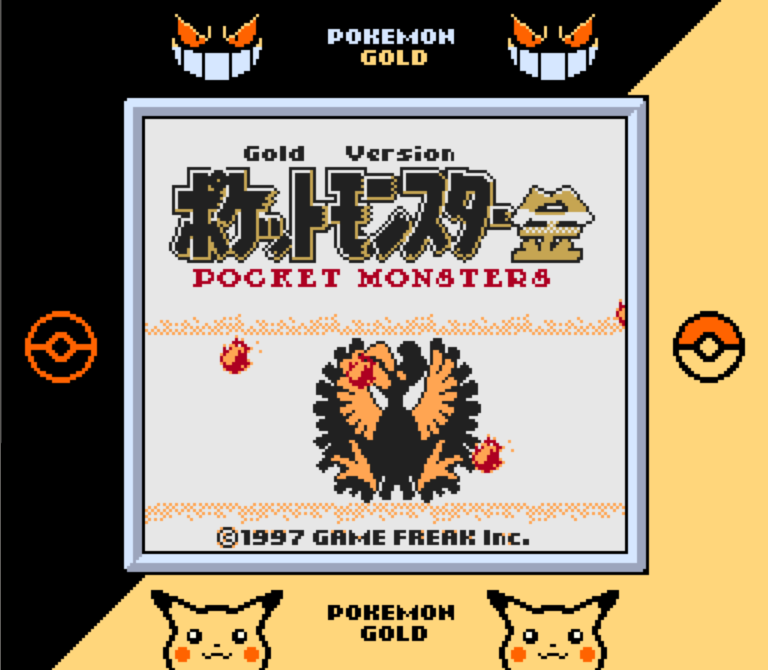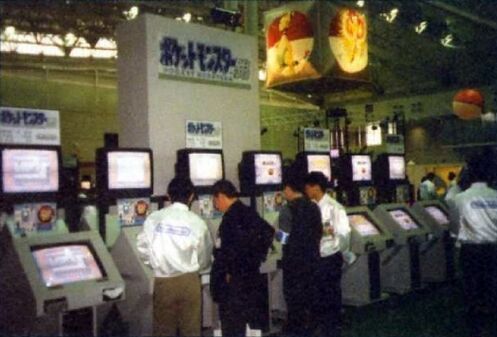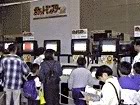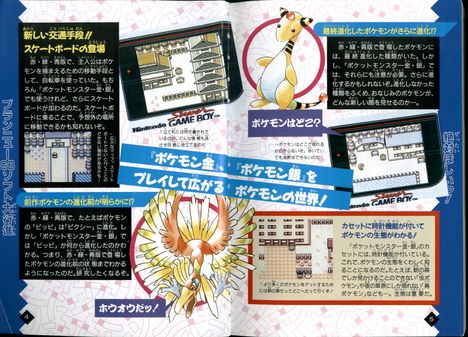Pokémon Gold and Silver Versions (found early SpaceWorld '97 demo build of Game Boy Color role-playing games; 1997)
Title screen for the 1997 Space World demo for Pokémon Gold.
Status: Found
Date found: 31 May 2018
Found by: Anonymous
Pokémon Gold and Silver (known as Pocket Monsters in Japan) are a pair of video games for the Game Boy Color developed by Game Freak. Being the second entry in the widely-popular Pokémon franchise and thus the first installment of what is colloquially known as Generation II (Generation I referring to Pocket Monsters Red and Green, Pocket Monsters Blue, Pokémon Red and Blue, and Pokémon Yellow), these titles introduced a number of series staples, including a real-time clock that affected encounter rates for the titular catchable monsters, the ability to import Pokémon from the previous generation, and the ability to find extremely rare alternate-color variations of Pokémon known as "Shiny Pokémon".
Development
The game had a lengthy development cycle. The games began development immediately after the release of Red and Green in February of 1996, and in August, Game Freak announced that the sequels were underway. In May 1997, the first details about Gold and Silver (then known as Pocket Monsters 2: Gold and Silver) were published in CoroCoro Comics magazine and stated that the games were set to release at the end of the year for the Game Boy. Like the Generation I games, Gold and Silver would be compatible with the Super Game Boy, which would provide the same minor enhancements that the preceding games supported (such as the ability to play the game in color, albeit limited to full-screen tints outside of battle). However, in March 1998, Game Freak announced on their website that the games would be delayed for an unknown period of time;[1] at this point, the "2" was dropped from the games' titles and they were re-announced as Pocket Monsters Gold and Silver, though the games' status as sequels to the Generation I games was still intact. That same year, the Generation I games would see a release in the West, where they would become a smash international success.
In early 1999, Game Freak announced that Gold and Silver would be re-tooled for compatibility with the then-recently released Game Boy Color while still remaining playable on the original Game Boy. The artwork of several new Pokémon was released along with a few screenshots. Eventually, after a rocky two-year development cycle (which included, among other events, the re-compression of the games' maps by Satoru Iwata), the games were finally released on November 21st, 1999, in Japan and October 25th, 2000, in the United States.
Differences Between the Demo and Final Game
In 1997, before the delay was announced, Nintendo's yearly Space World trade show was held in Japan, during which a playable demo of Pokémon Gold and Silver was showcased to the audience. What makes this demo so interesting is the significant amount of differences and aspects that weren't included in the final game - a reflection of how the games were intended to be before their retooling for the Game Boy Color. Some of the more notable differences are as follows:
- The title screen features a modified silhouette version of Ho-Oh's in-battle sprite (similar to the Generation I games, which featured the protagonist alongside a randomly-changing Pokémon sprite) instead of the final game's animation of Ho-Oh (in Gold) or Lugia (in Silver) flying through the air.
- The game's overworld is radically different, being designed after the entirety of Japan rather than just the Kansai region. As a byproduct of this, the Kanto region appears simply as a small, compressed town-like area located analogously to its real-life counterpart, as opposed to the mostly full version seen in the final games.
- Many of the original 151 Pokémon reuse their in-battle front sprites from Pocket Monsters Blue (analogous to Red and Blue internationally), and some of the newly seen back sprites appear to be designed to match the Blue sprites themselves.
- Most of the 100 new Pokémon seen in-game are vastly different in design and/or type from their final counterparts, with some of them being replaced or outright removed by the final release. Notably, the battle sprites of these beta Pokémon use a similar art style to that seen in Red, Green, and Blue.[2]
- In the case of newly-added Pokémon retained in the final release that are evolved forms of Generation I Pokémon, the evolutionary requirements for them differ significantly, with some involving the use of a "Poison Stone" that was ultimately never implemented.
- Wild Slowking can be encountered in tall grass; in the final game, Slowking can only be obtained by trading a Slowpoke holding a King's Rock. This was likely intended in order to show it off for the demo.
- The Fire-type and Water-type Starter Pokémon are a bear-like creature named Honooguma and a "Plesiosaurus"-like creature named Kurusu, respectively, as opposed to the final game's Cyndaquil and Totodile. "Hanamogura", Chikorita's first evolution, is also much different from Bayleef, being an anthropomorphic flower bud rather than the final game's dinosaur-like middle evolution.
The demo in itself lasted 10 minutes at first but was later shortened to 5 minutes due to waiting lines growing larger than anticipated. Players were allowed to walk around a limited portion of the game's overworld, starting off at the game's starting town, Silent Hills (renamed New Bark Town in the final game, likely to avoid trademark issues with Konami's Silent Hill series of games). The player was given a random Level 8 starter Pokémon holding a Berry; you could fight some wild Pokémon and even a couple of Trainers in the forest adjacent to Silent Hills. Following this, the player would encounter and speak to the rival character, at which point the demo would end.
Prior Availability
Some images and a 15-second silent video of footage from the demo were released online, but for 21 years, the rest of the demo remained lost, including in-game sprites of the original Pokémon designs. Although early Japanese Pokémon fansite owner Deme-rin's fanart of the game and scrapped Pokémon were readily available online, as well as others' descriptions of the demo experience, the actual nature of the game and its Pokémon remained a mystery. The game's overworld was also clouded in confusion, as only a small number of images of in-game areas were made available in gaming publications. In 2013, however, Twitter user Katsu_Nagao posted a candid image of Honooguma fighting a shiny Metapod.[3] During 2017, further footage from VHS tapes and European broadcasts featuring footage from the demo and its accompanying B-roll footage surfaced online gradually.
Resurfacing
On May 26th, 2018, an anonymous user posted a link containing four ROMs in the Discord server of Pret, a reverse-engineering team dedicated to disassembling games in the Pokémon series; two of these ROMs were identical to the ones available at Space World 1997, while the other two had extra debugging capabilities. The link posted was limited to 20 downloads before expiring. Until a disassembly and English translation were finished, the newly formed "Team Spaceworld" vowed to stay quiet about the leak until a full release of both the original ROMs and their translations could be done.
On May 31st, 2018, the four ROMs were leaked early on a 4chan imageboard before the translation or the disassembly was finished. These ROMs were then hosted and documented on The Cutting Room Floor, a wiki site devoted to documenting unused content, prototypes, and prerelease differences of video games. The wiki further publicized their existence and extensively documented the differences between them and the final games. Though the ROMs were released much earlier than initially planned, the disassembly has been finished; the English translation, meanwhile, is still in the works.
Shortly after the leak, a rumor surfaced that the original demo cartridge had been purchased by a late collector who, upon passing away, had his collection sold off by his family. According to this story, the cartridge then ended up in the hands of a shop owner who dumped its ROM on the internet after realizing what exactly it possessed. This story, however, has been proven to be a fabrication by another 4chan user falsely claiming to be the owner of the ROMs.
How the original leaker came into possession of the cartridge in the first place is uncertain, with only rumors floating about. The owner of Pokémon fansite Serebii treated it with caution due to the possibility that it could have been obtained in an illegal manner.[4]
Gallery
Images
Videos
See Also
Online Content
- Chuggaaconroy (found early Pokémon Platinum videos from YouTuber; 2008)
- Pokémate (lost inaccessible "Pokémon" Japanese mobile phone app; 2006)
- PokéPark: Asari Taikai DS (lost "Pokémon" Nintendo DS Download Play game; 2005)
- Pokémon Crystal Version (lost Japan-only Mobile Adapter GB content for Game Boy Color role-playing game; 2001-2002)
- Pokémon Mystery Dungeon: Gold Rescue Team -Challenge the Gold Rank!- (lost South Korean promotional demo of Nintendo DS game; 2007)
- Pokémon Mystery Dungeon: Rescue Team (partially found official website content of Nintendo DS/Game Boy Advance games; 2006)
- Pokémon 2000 Adventure Game (partially found browser-based online game; 2000)
- Pokémon.com (lost online games from website; pre 2010-2011)
- Twitch Plays Pokémon (partially found footage of Let's Play channel; 2014)
Video Games
- Pokémon PC Master (partially found Japanese educational PC game; 2006)
- Pokémon Picross (found build of cancelled Game Boy Color puzzle game; 1999)
- Pokémon Pink Version (lost build of cancelled Game Boy role-playing game; existence unconfirmed; late 1990s)
- Pokémon Stars Version (lost enhanced Nintendo Switch port of "Pokémon Sun and Moon" Nintendo 3DS role-playing games; existence unconfirmed; 2017)
- Pikachu: DS Tech Demo (lost "Pokémon" Nintendo DS tech demo; 2004)
- PokéROM (found "Pokémon" edutainment series; 2000)
External Links
- Spreadsheet of differences between the Space World demo and the final game.
- Page on The Cutting Room Floor documenting the full list of differences between the 1997 demo and the final games.
References
- ↑ Archived Game Freak website (in Japanese) announcing the games will be delayed. Retrieved 22 Feb '19
- ↑ Polygon article that talks about the unused Pokémon beta designs. Retrieved 23 Feb '19
- ↑ A screenshot of the game posted by a Twitter user in 2013. Retrieved 22 Feb '19
- ↑ Serebii owner’s Twitter post about not releasing information due to potential legal actions. Retrieved 31 May '18



